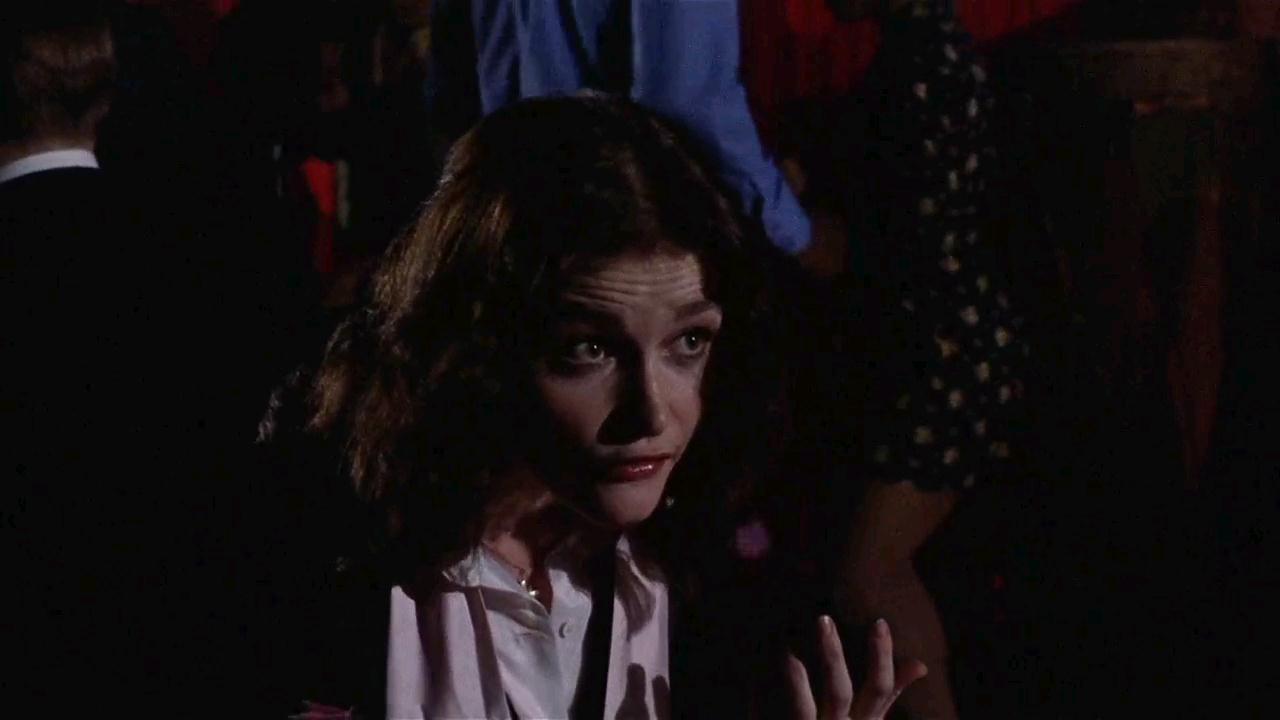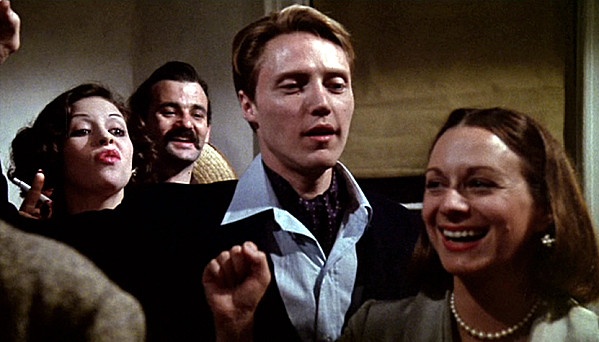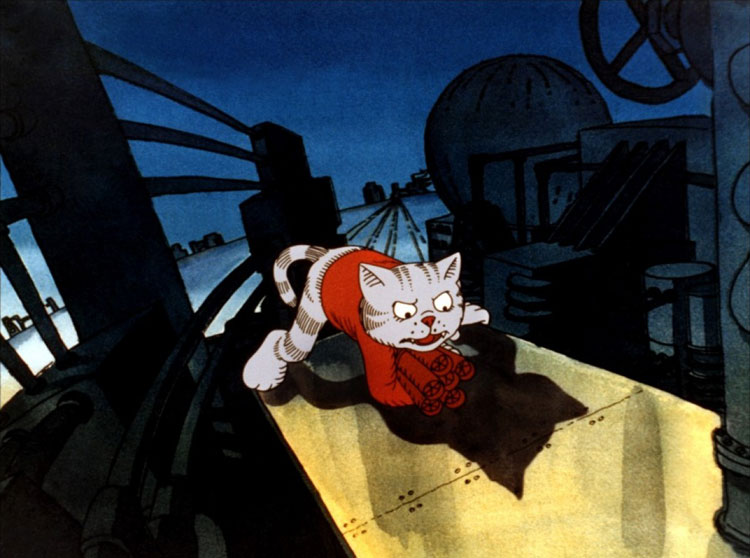24. Sisters (1973)
It’s hard to believe that Alfred Hitchcock wasn’t always a critical darling, but in more conservative times he was considered just a skillful maker of suspense thrillers. However, in New Hollywood era and later, young directors who had grown up with Psycho (1960) and The Birds (1962), among others, both venerated and emulated the Master of Suspense.
Surely no young film maker ever took this devotion to the limits explored by Brian Di Palma, who spent well over a decade creating one “homage” after another to Hitchcock.
Perhaps the best, certainly the one with the most life, was Sisters. This later day effort from 1960’s exploration studio AIP, featured a more substantial budget than many of their films and ended up getting some kind words from critics. The plot features Margot Kidder as separated Siamese twins, one of whom is psychotic and a murderer. Jennifer Salt plays a plucky reporter living across the street who happens to look out of the window at the right moment and resolves to sort it all out.
Owing more than a little to Psycho and 1954’s Rear Window, Sisters is really somewhat silly but De Palma’s style, including interesting use of the split compositions which marked his early films, helps to pull it off along with the performances of actors who know what they’re doing (including the great character actor Charles Durning and Olympia Dukakis in a small role).
The film also opens with a sharp satire of reality/game shows. (Note: Miss Salt, daughter of famed blacklisted screenwriter Waldo Salt, is now a writer-producer, notably of the TV show American Horror Story, and cribbed liberally from this film for the show’s third season.)
25. Next Stop, Greenwich Village (1977)
Paul Mazursky was in show business all his life, as child and adult, theater, movies and television, and as actor, writer and director (and success behind the camera didn’t stop his acting career). He had his hits such as 1969’s Bob and Carol and Ted and Alice and 1978’s An Unmarried Woman and his flops, but he was always an interesting deeply felt film maker.
Though it didn’t make hit status, Next Stop, Greenwich Village stands as one of his best films and surely his most personal. Simply put, this film is the story of how young Paul left his loving but smothering Brooklyn based family and set out on his own. It’s funny and touching and authentic and a loving tribute to an impossible but caring mother (Shelly Winters in perhaps the best performance of her career).
Stage actors Lenny Baker (a talent who would sadly die just a couple of years later) and Ellen Greene head an excellent cast which includes Christopher Walken, Lois Smith, Lou Jacobi and Antonio Fargas. This type of personal cinema was New Hollywood at its best.
26. Such Good Friends (1971)
Bullying, autocratic director Otto Preminger fought censorship of all kinds for years (he helped to end the blacklist). Sadly, he began to diminish as a film maker around the time the New Hollywood he (inadvertently) helped to bring about took hold. However, he did get in a few, well, interesting films before darkness fell. One that couldn’t have been made any earlier was Such Good Friends, a story concerning a woman’s liberation during a time of crisis.
That sounds lofty and worthy, doesn’t it? In point of fact, the resulting film is anything but lofty or worthy (well, not in a certain sense, anyway). Based on a best seller of the day and ghost written by the talented Elaine May, the film relates the story of Julie (a bubbly Dyan Cannon), an upper class Manhattanite who is in for a big shock when her hubby (Laurence Luckinbill) goes to the hospital to have a mole removed.
The inept doctors maneuver this simple procedure into a life and death affair, causing Julie to go through his personal papers while getting things in order. She discovers his personal journal, which chronicles the fact that he’s had sex with pretty much all of their female friends and others. She decides that it’s time to even the score, but finds that the sexual revolution is more easily observed than joined.
Preminger was never accused of good taste on even his best days and this one won’t change any minds about that. However, it is an interesting attempt to use the new freedoms of that film era and the New York based cast (James Coco, Ken Howard, Nina Foch, Jennifer O’Neill and Burgess Meredith, among others) is more than game and able. While no masterpiece, this one is amusing.
27. The Sugarland Express (1974)
While Steven Spielberg’s vaunted directorial career is far from a disgrace, one can’t help but wonder what it might be looked like if one earliest and best films hadn’t flopped at a most inconvenient moment in time.
Taken from a fact based story, the film centers on a likable but limited young woman (Goldie Hawn in surely the best performance of a career not noted for acting quality), the wife of a harmless petty criminal (William Atherton), who she convinces to make a prison farm break just days shy of being paroled.
It seems that the authorities are planning to relieve the pair of the custody of their infant child, since they are deemed unfit parents and the woman wants the husband to help coerce the authorities into given the child back. The situation quickly escalates as the pair hold a young policeman hostage and inadvertently start a caravan going across the state of Texas, to the cheers of the mindless crowd.
This sounds zany and there are comic moments in the first half, but these drain away as the story moves towards a factual tragic ending. The studio pushed it as a fun, folksy film but its not that at all.
Spielberg sharply observes the wife and husband as not bad people but dim and naive, matched by the members of the crowd who thoughtlessly support the pair’s mindless plan. Thereafter Spielberg went the way of the crowd as well, until he felt safe enough to start throwing caution to the winds again. Sadly the same studio took the same basic idea a few years later and had a big hit with the loud, empty, mindless Smoky and the Bandit. Where’s the justice?
28. The Last Detail (1974)
The Last Detail stand as another lost masterwork from director Hal Ashby. Columbia knew that it had a potential critical and commercial hit on their hands with the film and employed a strategy which never works: they gave the film a limited release at holiday time in order to gain award nominations, then pulled the film until after the nominations were made, killing all audience buzz.
The film was taken from a novel by Daryl Ponicsan (who also sold another novel, Cinderella Liberty, to Hollywood that same year for another interesting and little seen film). The story concerns two Navy lifers (Jack Nicholson and Otis Young) who are assigned to take a hapless young sailor (Randy Quaid) to naval prison several states away.
The young man has been given a surprisingly harsh sentence for stealing from a charity box (the charity was the pet of the commanding officer’s wife). His youth will be gone by the time he gets out. The two older men decide to take the long way in delivering the kid to prison and determine to show him all the things he will otherwise miss out on.
This is really a sentimental story, but the style isn’t sentimental. The sailors, especially the older men, look, act and truly talk like….sailors. The pleasures that they show the kid aren’t of the innocent kind but do ring true.
The acting, particularly Nicholson as a man who still has a kind soul despite a rough path in life, is excellent. The other star is Ashby, who always had a way of interpreting the feelings of common, real-life people and respecting the decency of their situations and behavior. Almost any other era in Hollywood history would have ended the film with a clever solution which would have let the boy off the hook, but this film leaves what is as it is and ends up packing an emotional punch thanks to that fact.
29. Citizen’s Band (1977)
Thanks to the internet, the idea of people adopting an assumed persona while interacting with each other through social media is now commonplace. This was not the case in the 70s when many were taken with the first crude form of this, the medium of citizen’s band radio, a forum originally used for long haul truckers through which people communicated behind “handles”, colorful names which masked their identities (used for good reasons by the truckers, an affectation for others).
When Paramount decided to release a film based on this fad, the studio should have known better than to assign it to the talented Jonathan Demme, who decided to craft a film with looked at how the assumption of a different identity affects the lives of several grass roots Americans. Paul LeMat portrays a small town CB coordinator obsessed with the medium and bugged by a rogue user.
Candy Clark, LeMat’s co-star in American Graffiti, is his on and off love interest with the atmospheric character actor Roberts Blossom as his crusty father with an alternate CB persona. There is also a high amusing sub-plot involving a bigamist trucker (Charles Napier) whose two wives (Marcia Rodd and a wonderful Ann Wedgeworth) inadvertently meet. Demme displays the same sensitivity and respect for everyday life which would mark his work.
30. Fritz the Cat (1971)
Everything seemed to get reworked in New Hollywood, so why not animated films? However, no one expected an X-rated cartoon (and, yes, it deserved that rating)! This film was the long gestating brain child of Ralph Bakshi, a veteran animator who had long worked in more conventional projects (such as Mighty Mouse cartoons). He obtained the rights to the hit underground comic strip Fritz the Cat, penned by the redoubtable R.Crumb, a scathing social satirist employing the comic medium.
Essentially the film follows the life path of Fritz, a really hip cat (and all of the with-it guys in his world are cats) who lives to ingest illegal, mind enhancing substances and have sex with every viable female in sight (and all the females are, implausibly, dogs). His big obstacles are altercations with an endless stream of authority figures (pigs in this world) and frequent run-ins with members of minority groups (blackbirds, always).
Does the animal imagery sound offensive? Well, the world into which New Hollywood was delivered was not politically correct (which also accentuates its appeal).
The film (which Crumb typically hated) is very gamy and rather course in its satire, but it helped to break the stranglehold the Disney style of animation held over feature length animated films up until that time. Bakshi made a number of other similar films until that vein dried up and he….went back to Mighty Mouse.
Author Bio: Woodson Hughes is a long-time librarian and an even longer time student/fan of film,cinema and movies. He has supervised and been publicist for three different film socieities over the years. He is married to the lovely Natalie Holden-Hughes, his eternal inspiration and wife of nearly four years. You can visit his blog at Stream of Dreams.






